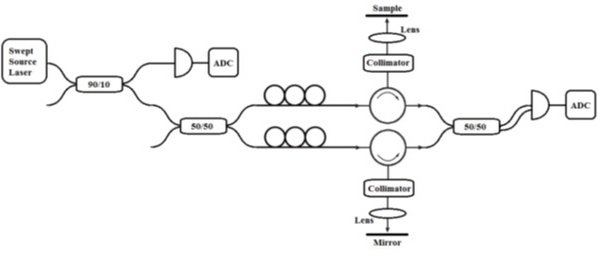Below you can find the Bachelor end projects of PhI.
NB. When more than one assignment is defined in a project, there may be a possibility to perform projects in a team.

Laser based diagnostic medical imaging
BACHELOR END PROJECT: Laser- based diagnostic medical imaging
Track: Care and Cure
Group: PhI
Mentor: Dr.E.A.J.M. Bente
General description:
This project concerns the imaging technique named Optical Coherence Tomography. This technique enables you to look upto a few millimeters inside e.g. biological tissue. One can obtain images as if one had made a cross-section. The technique utilises the phase information of the backscattered laser light from a tunable laser. The quality of the image and the information one can obtain depends on the wavelength light used. In this project the use of wavelengths around 1550nm is explored.
Students task description:
An existing experimental imaging set-up which records 1 dimensional traces of depth information can be improved to provide recording of 2D or even 3D images of phantom samples. For this a method for moving the sample and the data aquisition must be designed and implemented. On can investigate how to optimise the control, signal acquisition, laser scan strategies and image quality.
Laser-based ranging in cars
Laser-based ranging in cars
BACHELOR END PROJECT: Laser- based ranging in cars
Track: Smart Mobility
Group: PhI
Mentor: Prof. K.A. Williams
Context:
The deployment of light based detection and ranging (LIDAR) is now sufficiently miniaturized to create the first prototype self-driving cars. However the hardware is still physically very large, prohibitively expensive, and aesthetically challenging. Recent innovations in photonic integrated circuit technology could enable radical size reductions, systems integration, and reduced costs. This is critical to a larger scale deployment of LIDAR and a range of other safety-critical systems.
Assignment B3) In this work you will review current state-of-the-art laser systems which are being used in the first prototypes. You will perform an analysis of key requirements from the laser and detection systems, including optical and electrical power, beam control, scanning systems, eye-safety limits, environmental impacts. You will create a design using a new class of components which could all be manufactured together in integrated photonics and make performance projections.
Activities:
Literature study, calculations. Design and simulation of a photonic IC. Writing of report.
Automated alignment at the nanometer scale
BACHELOR END PROJECT: Automated alignment at the nanometer scale
Track: Connected World
Group: PhI
Mentor: Dr. X.J.M. Leijtens
Context:
Photonic integrated circuits require innovative new methods for test and characterisation. In our laboratories, the optical connections are made with state of the art motorized stages which guarantee a very large range of movement (~cm) with an unprecedented accuracy (1-2 nm). The very high movement precision together with the high resolution cameras make this setup extremely flexible. However the high movement accuracy makes the alignment optimization time consuming and user dependent.
Assignment B7) To simplify this alignment procedure the student will develop a LabView algorithm that maximizes the measured power by automating the movement of the translation stages. This will allow faster measurements with higher repeatability. The student will have the chance to operate state of the art equipment, devise sophisticated control algorithms and finally apply the algorithm that he/she will have developed in optical measurement.
Assignment B8) The objective of this assignment is to develop software that produces a sound signal proportional to the power coupled in an optical fiber from a Photonic Integrated Circuit (PIC). The sound module needs to integrate with our other control software and communicate with other lab equipment. This is written in LabView or LabWindow/CVI. The new module should be able to continuously readout the power meter and produce a sound e.g. through the computer’s sound card. The precise relation between the characteristics of the audio signal and the power has to be optimized by the student.
Activities: Learning Labview, performing measurements, implementing algorithms, analyzing results, reporting.

Precision optical alignment
BACHELOR END PROJECT: Electro-optic phase modulators
Track: Connected World
Group: PhI
Mentor: Dr.E.A.J.M. Bente
General description:
An electro-optic phase modulator is a device that can change the phase of a light wave passing through as a function of a control voltage. This can be used e.g. to encode analog or digital signals on a light wave, but also to generate a frequency comb. Integrated electro-optic phase modulators are realised as optical waveguides in semiconductor material and this gives the modulator very specific properties since the light may generate free charge carriers in the modulator.
Students task description:
The student will design and setup methods to accurately determine the voltage - phase relationship of electro-optic phase modulators for various optical signals (continuous light and ultra-short pulses) passing through the modulator as well as quantify residual amplitude modulation. This work will involve experimental work on the set-up and theoretical work analysing the result and establishing the accuracy of the measurement.
